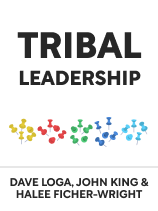

This article is an excerpt from the Shortform book guide to "Tribal Leadership" by Dave Logan, John King, and Halee Fischer-Wright. Shortform has the world's best summaries and analyses of books you should be reading.
Like this article? Sign up for a free trial here .
What’s a tribe? How do tribal cultures develop? What does a tribal leader do?
In the book Tribal Leadership, Dave Logan, Halee Fischer-Wright, and John King contend that organizations succeed or fail on the strength of their tribes—groups of individuals with shared social norms and ways of working. They argue that you can improve your organization by elevating the cultures of those tribes. If you implement their strategies, the authors say you’ll improve both your bottom line and the happiness of your employees.
Take a look at our overview of the book, and see what you can apply to your own organization and leadership.
Synopsis of Tribal Leadership
Logan, King, and Fischer-Wright bring diverse expertise to the table. Logan is a senior lecturer at the USC Marshall School of Business and a business consultant through his company, CultureSync, while King coaches executives in leadership skills. Fischer-Wright is a licensed physician and former business consultant. The book Tribal Leadership synthesizes their shared expertise in business management, leadership, and cultural transformation.
Our overview begins by presenting the “tribes” framework—what a tribe is, how tribal cultures develop through five stages, and what a tribal leader does. We’ll take a look at what the stages are and how they work before detailing each of the five tribal stages’ characteristics and how to level up to the next stage.
Humans Coordinate in Tribes
The authors explain that humans instinctively form tribes—in other words, we’ve evolved to organize ourselves in medium-sized groups of like-minded people. A tribe is a group of 20 to 150 people who readily recognize one another and generally get along. A tribe is a social network before it’s a work group. For example, the people you instinctively reach out to in crises are part of your tribe. An organization can have multiple tribes.
According to the authors, the strength of an organization’s tribes determines the strength of the organization. In turn, the strength of a tribe depends on its culture—how the members speak, relate to values, and form relationships. For example, if a tribe is made of ambitious, values-driven team players, it’ll contribute positively to the organization.
(Shortform note: While the authors don’t provide a source for this number, the upper bound of 150 matches “Dunbar’s number,” a theoretical upper limit to the number of close relationships that a human can maintain. Dunbar calculated this number by comparing primate brain sizes to group size, and for humans, he found hunter-gatherer communities were “almost exactly 150” members.)
Tribal Culture Develops Through Five Stages
The authors say that tribes develop through five distinct stages:
- Stage 1: Struggling to stay afloat—Stage 1 tribes (such as gangs) form from individuals who’ve been born into underprivileged circumstances.
- Stage 2: Resigned mediocrity—Stage 2 tribes are tired and disconnected from their work. They achieve average results, innovate little, and live for the weekends.
- Stage 3: Survival of the fittest—Stage 3 tribes are competitive networks of ambitious, career-focused individuals. They achieve great results but struggle to work together.
- Stage 4: Unified teamwork—Stage 4 tribes work as a team, and they’re productive, innovative, and connected to their work.
Additionally, the authors mention a fifth stage, at which teams perform ”world-changing innovation,” but they acknowledge that exploring it was beyond the scope of Tribal Leadership at the time of publication.
| The World of Developmental Stage Models With these five stages, the authors step into the field of adult development, a branch of science that attempts to model how humans develop into young adulthood and throughout life. This field continues the work of psychologists who studied child development, such as Jean Piaget, who pioneered a theory of childhood cognitive stages. Developmental models suggest that there are distinct, discrete stages that people go through as they age—stages that we can measure, describe, and verify. Theorists also describe different developmental lines, such as cognitive, social, and spiritual development. In The Listening Society, Hanzi Freinacht explains that there are domain-specific and domain-general developmental models. Tribal Leadership is a domain-specific model—it attempts to explain how individuals, tribes, culture, and leaders develop in a business context. |
Each of these five stages exhibits several key markers:
- Marker #1: Tribe members speak a common language. People at each tribal stage use words and phrases characteristic of that stage. Particularly, the authors say that these language habits express their values—whether they deride them or hold them dear.
- Marker #2: Tribe members form relationships that flow from how they see values and how they speak. For example, people at Stage 3 build two-person relationships because they value power and control.
| Spiral Dynamics and Tribal Leadership In Spiral Dynamics, Don Beck and Chris Cowan lay out their developmental stage model—a model from which the authors of Tribal Leadership draw. In Spiral Dynamics, each stage corresponds to a “value meme” (differentiated by colors), or a coherent system of values (a worldview). A person at a given stage expresses their value meme through their characteristic behaviors, attitudes, beliefs, problem areas, and so on. In this guide, we’ve placed the emphasis on how a tribe’s language expresses its values since, unlike Spiral Dynamics, the authors of Tribal Leadership avoid discussing anything “interior” to the person, such as beliefs or attitudes. |
Tribal Leaders Develop the Tribe
According to the authors, the tribal leader upgrades her tribe by coaching individuals one at a time until the whole tribe levels up. She learns to recognize the two key markers of each cultural stage, and she uses them to identify the tribes in her organization and start to upgrade their cultures. Then, a tribal leader coaches people one at a time through the two core coaching opportunities of each stage: Changing the individual’s language and relationships.
- First, change his language. According to the authors, an individual’s language indicates how he sees reality. By changing his language, you help him adjust his view of how things work.
- Second, encourage him to build relationships. Strong relationships make a strong tribe, and building relationships helps a tribe member recognize his peers and gain support.
The authors assert that when a tribal leader helps enough individuals upgrade their stage, the entire tribe will “tip over” into that next stage. Some tribe members will head toward higher stages before others, but once the leader creates that critical mass of aspiring individuals, the whole culture will level up.
| Critical Mass and the Flywheel Effect The authors’ notions of cultural transformation and of the leader-tribe relationship invoke one underlying principle—build momentum—in two forms: Create a critical mass: By accumulating enough energy moving toward the next stage up, you create a self-reinforcing feedback loop. In other words, get enough people on board and they’ll continue to fuel the cultural transformation even when you stop actively pushing the tribe along. Create a flywheel effect: By developing and inspiring her tribe, the leader gains reciprocal goodwill and effort from the tribe members. As she “pushes” the cultural flywheel with her efforts, the tribe “pushes” along as well and, in time, they create a self-sustaining feedback loop that further develops the leader and tribe. |
Stage 1: Life Is a Struggle
The authors explain that at Stage 1, individuals see the world as a harsh, dog-eat-dog environment. Their lives are generally cruel and punishing, and they become both miserable and tough.
For the individual at Stage 1, things have never been easy. He likely grew up in poverty and has been exposed to criminal influences. Stage 1 individuals often resort to crime or have major vices, such as a drug addiction. Because of this, Stage 1 individuals struggle to hold down work—the authors say that they make up just 2% of the workforce. Stage 1 has two markers:
- Marker #1: Language reflects misery. According to the authors, Stage 1’s language centers around the idea that life is fundamentally unfair—that the game is rigged. Given this, people at Stage 1 see values as lies to keep people disadvantaged and weak. To them, the truth is that life is unjust and cruel.
- Marker #2: Relationships are strained or broken. For individuals at higher stages, the anything-goes behavior of Stage 1 is often too much to handle, so the Stage 1 individual easily loses friends and work.
(Shortform note: Tribal Leadership’s Stage 1 corresponds to the “beige” level or “value meme” from Spiral Dynamics. At beige, a person’s primary concern is survival, and he lives largely from instinct. In general, he aims to meet his physiological needs—food, water, shelter, sex—and can’t spare much thought for self-development. Given this, it makes sense that Stage 1 individuals don’t see life as bright, open, or full of potential.)
Paths to Stage 2: Overcome Despair
The authors explain that a tribal leader can coach an individual from Stage 1 to Stage 2 using the two core coaching opportunities:
- Opportunity #1: Swap Stage 1 language for Stage 2 language. Help the Stage 1 individual see that life does work for some people. Seeing this, he’ll recognize that life isn’t universally awful, and that it might work out for him someday.
- Opportunity #2: Help him build relationships with a higher-stage tribe. Joining a higher-stage tribe—such as a volunteer group or religious community—gives a Stage 1 individual the support he needs to overcome vices and change his Stage 1 behaviors.
According to the authors, three changes mark a successful shift from Stage 1 to Stage 2:
- Change #1: Shifting language. The Stage 1 individual stops expressing that life is fundamentally unfair, and he starts to say that his life specifically is bad.
- Change #2: Tired resignation. The authors explain he’ll often become resigned: He’s unhappy that his life hasn’t worked out yet, but he sees that it can.
- Change #3: Social shifts. When he moves toward Stage 2, the Stage 1 individual leaves behind relationships with people at Stage 1.
| Develop a Coaching Habit While the authors don’t explain coaching in-depth, Michael Stanier offers a simple solution in The Coaching Habit: Develop a daily habit of coaching your team members. Specifically, Stanier recommends asking good questions and listening more than you speak. Three of Stanier’s questions apply best to Stage 1: “What’s on your mind?”—This gently opens the conversation. “Anything else?”—This encourages people to say things that might be difficult to say. “How can I support you?”—This communicates that you hear, see, and want to help this person. By using these questions well, you can build a relationship with a Stage 1 individual who’s likely never had support, and you can guide him to a healthier way of living. |
Stage 2: Resigned Mediocrity
The authors explain that Stage 2 culture is an apathetic mood characterized by passivity and disinterest in the work at hand. This culture is common at places such as the post office, chain retail stores, and other menial jobs.
In a Stage 2 culture, everyone fixates on the negatives, allowing their circumstances to define them. Since negativity is contagious, this creates a downward spiral that yields a perpetually unhappy atmosphere. As with Stage 1, Stage 2 has two key markers:
- Marker #1: Commiserating language. In a Stage 2 tribe, the authors say that people commiserate about things such as how management mistreats them, and they often bemoan corporate heavy-handedness.
- Marker #2: Tenuous relationships. Since Stage 2 features mainly commiseration, people’s relationships don’t grow beyond the support of shared griping.
| Robert Kegan’s Developmental Stages Stage 2 of Tribal Leadership corresponds to Robert Kegan’s model of ethical, social, and cognitive development. For clarity, we’ll refer to it as “the communal mode.” Stage 2 exists in the communal mode, wherein individuals understand themselves based on how others see them. Collectively, people adhere to group norms and avoid taboos. Since group norms are paramount, people in a Stage 2 office show solidarity when someone complains about work. Kegan’s model illuminates why Stage 2 cultures perpetuate a low bar of mediocrity: In the communal mode, it’s very difficult to break the status quo. Doing so would mean losing many of your relationships and being ostracized. |
Paths to Stage 3: Inspire Ambition
To coach individuals to Stage 3, find the few who are ready to level up and work with them one-on-one using the authors’ three steps:
- Step #1: Speak with Stage 3 language. This will help the Stage 2 individual learn and absorb the Stage 3 attitude, and she’ll begin to recognize her abilities to succeed.
- Step #2: Show the individual that you value her. Since the Stage 2 individual has often become disillusioned with management, you need to gain her trust. The authors recommend that you get to know what she does and what she’s accomplished.
- Step #3: Encourage two-person relationships. The Stage 2 individual needs to develop better connections to move up. Encourage her to seek new friendships, especially with people who are at Stage 3.
Two main changes mark a successful shift from Stage 2 to Stage 3, according to the authors:
- Change #1: The Stage 2 individual starts using Stage 3 language. Instead of expressing that her life sucks, she’ll start to recognize her own potential—and she’ll express that with language like, “I’m awesome, I can definitely succeed.”
- Change #2: The Stage 2 individual assumes the mood of Stage 3. Now that she’s begun to recognize her own abilities and develop her confidence, the Stage 2 individual will assume the competitive attitude characteristic of Stage 3.
| Encourage Nonlinear Development Tribal Leadership presents a linear progression up the stages within one company. But while we’ve long thought of careers as climbing rungs on a ladder, a linear career path doesn’t always make sense. Instead, today’s workers must learn to navigate an unpredictable, ever-changing landscape of opportunities, finding a less direct path to career success and fulfillment. When using Tribal Leadership’s coaching tactics, help your mentees understand that they don’t necessarily need to pursue a linear career. Encourage them to develop transferable skills, such as writing or productivity skills, so that they have more options when searching for roles. Last, kindle an employee’s ambition by finding what motivates them and giving frequent feedback. This way, you can assign her to tasks that develop her skills and help her clearly see how she’s doing. |
Stage 3: Survival of the Fittest
The authors describe Stage 3 as the domain of “lone warriors,” where big egos jockey for power and personal accomplishment. It’s the most common culture, and where most professionals spend much of their careers. Stage 3 is highly individualistic, so members don’t see themselves as a tribe. However, they still share a particular culture: Shark-like competition, power politics, and high ambition.
(Shortform note: Recent trends suggest that collaboration is replacing the competitive workplace. About 88% of the millennial workforce reports that they prefer collaboration over competition. To the millennial employee, happiness and overall fulfillment matters more than career success, so many millennials might be jumping right to Stage 4 to avoid the ferocious competition of a Stage 3 work environment.)
The authors explain that Stage 3 has two distinct markers:
- Marker #1: “Me first” language. Stage 3 features egocentric language, and “I” starts most sentences. Stage 3 individuals say, “I can do it best,” or, “Let me figure it out.” Since a Stage 3 individual values himself first, he favors his own goals, ideas, and ambitions while often disregarding others’.
- Marker #2: Power politics. The Stage 3 individual hoards and controls information with one-on-one relationships. He’ll rely on gossip from spies in lower company positions, and he exerts a lot of energy to keep everything under his control. This tense, politics-heavy environment prevents effective teamwork.
(Shortform note: In Spiral Dynamics, Don Beck and Chris Cowan describe an “orange” value meme that corresponds to Tribal Leadership’s Stage 3. “Orange” individuals aspire to improve themselves, and they use rational, strategic thinking to dominate and win. In the workplace, Stage 3 individuals can be antagonistic and difficult, but they recognize that individualism contributes to innovation—think of people such as Steve Jobs, who demonstrated what audacious individual ambition can create.)
Paths to Stage 4: Embrace Teamwork
The authors describe two key coaching opportunities for helping individuals move from Stage 3 to Stage 4. Work one-on-one with Stage 3 individuals who are ready to make the shift.
- Opportunity #1: Encourage interpersonal cooperation. A Stage 3 individual can overcome his antagonistic individualism by learning to treat others with respect and dignity. Encourage him to get candid feedback through surveys, communicate transparently, and recognize the unique skills of his employees.
- Opportunity #2: Demonstrate the limitations of Stage 3. Since results matter most to the Stage 3 individual, emphasize that Stage 4 performs more effectively than Stage 3. Show him that working on a team will expand his reach and give him back his time.
(Shortform note: While the authors don’t cohere their coaching tactics into an overall system or framework, consider that you might not need a singular coaching system. Instead, gather a variety of tools and techniques into a coaching “toolkit,” or a repertoire that you can continually add to. For instance, you might combine the authors’ techniques with Kim Scott’s strategies from Radical Candor, in which she argues that bosses can better manage relationships by caring personally and challenging directly. By combining tips and tactics from a variety of sources, you can develop a skill set that’s tailored to your own needs.)
The authors describe three changes that mark a successful shift to Stage 4:
- Change #1: A shift to team-focused language. The Stage 3 individual will begin to credit his team with their successes and downplay his own role.
- Change #2: Stronger relationships. He’ll recognize the advantages of transparent, three-person relationships, and he’ll begin to build a stronger network.
- Change #3: Increased effectiveness. As the Stage 3 individual embraces teamwork and the power of networks, he’ll begin to achieve more with less personal effort.
(Shortform note: In Team of Teams, Stanley McChrystal explains how, when you develop people who trust one another and have a shared purpose, you strengthen the small units (such as teams or tribes) that make up your organization. In Navy SEAL training, prospective SEALs spend six months in groups of five to eight, and they learn to communicate clearly, trust and take cues from one another, and operate as a unit. The SEALs’ trust and shared purpose create a strong, unified team, and this same principle can create strong teams or tribes in your organizations too.)
Stage 4: Unified Teamwork: The Tribe Comes First
According to the authors, just under a quarter of the modern workforce exhibits Stage 4 culture. Like the previous stages, Stage 4 has two characteristic markers: its language and its relationships.
Marker #1: Tribe-Focused language. In a Stage 4 culture, the prevailing mood is one of camaraderie and authenticity. Tribe members and leaders feel that they’re doing great work, and they openly express it—leaders usually credit their tribe for any success, while tribe members praise the leader. This language also expresses the tribe’s values, which keep members aligned toward a common mission.
(Shortform note: The authors’ description of a Stage 4 tribe evokes the camaraderie of a sports team, wherein the team’s success explicitly depends on how good team members feel about themselves and each other. In this same vein, some collaborative companies use sports-themed retrospectives to review their work and stay aligned, since sports offer a rich array of team-building exercises and wisdom to draw from.)
Marker #2: Strong, networked relationships. To the Stage 4 person, the tribe comes first, so he’s always looking to build strong relationships or introduce people he thinks might work well together. The authors explain that these relationships typically have three members.
(Shortform note: The McKinsey Institute suggests that successful organizational change often comes from focusing on the informal networks within your company, rather than trying to restructure the various departments and teams of a typical organizational chart. They argue that these networks determine what gets done, much like the authors’ view of tribes.)
Establish Your Values and Purpose
According to the authors, a tribe must establish and live its core values and find a purpose to stabilize at Stage 4. When the tribe has a solid foundation of values and an inspiring purpose to pursue, they come together and become more effective and innovative at work.
Find and Live Your Values
The authors offer these tactics for finding and living your values:
- Tactic #1: Create your values with the whole tribe. Hold a meeting—or a few—and use open-ended questioning, such as “What matters most to you?” to dig down and find shared values. Work with your tribe to articulate them.
- Tactic #2: Talk about values often. This encourages tribe members to continue thinking about the values and they’ll often suggest nuances, clarifications, and adjustments.
- Tactic #3: Hire according to your values. Test for values in an interview by telling a story that illustrates a core value of yours. If the interviewee can articulate the point of the story, you’ll know they understand that value.
| Values Form a Core Philosophy In Built to Last, Jim Collins explains that companies that achieve lasting success operate on a core philosophy—values that guide the company through thick and thin. To develop a core philosophy, consider Collins’s steps: Craft your core philosophy with five to seven employees who already exemplify it, as opposed to working with the whole tribe. Keep it concise. Stating your values plainly clarifies them for everyone. Limit yourself to three to six core values. Any more, and it’s no longer an essential core so much as a loose list. |
Unite With a Worthy Purpose
After establishing shared values, a Stage 4 tribe must find a worthy purpose—the tribe’s North Star, or overriding direction. The authors recommend making this purpose audacious rather than realistic since boldness unites people better than an easy, unambitious aim. They give two ways to find a worthy purpose:
- Method #1: Ask what the tribe works in service of. Have everyone explain their answer, and discuss until someone’s answer resonates with the whole group.
- Method #2: Ask four key questions. According to the authors, asking these questions allows a group to review their current situations and get a sense of where they want to head. “What’s working well?” “What’s not working?” “What can we do to make the things that aren’t working work?” “Is there anything else?” (Shortform note: These questions are a common review method: Reflect on the positives, then the negatives, then figure out what to change. For instance, James Clear uses much the same method for his annual review, asking, “What went well? What didn’t? What am I working toward?”.)
(Shortform note: Instead of starting with values, the Harvard Business Review writes that a company’s purpose comes first. They define “purpose” as “your company’s reason for being,” and say it acts as the center of a “compass” that guides a company’s values, strategy, brand, and vision. A purpose should differentiate the company and suggest its values: For instance, a minimalist, sustainable footwear brand might stand for “healthier feet and a healthier planet.”)
Markers of Success: Cherishing the Tribe
The authors describe three main changes that occur when an individual has stabilized at Stage 4.
- Change #1: Tribe-focused language. At Stage 4, a tribe member will use tribe-focused language, often praising her team and crediting them for any successes.
- Change #2: Commitment to the tribe’s values. When faced with decisions, the tribe member will choose according to the tribe’s values and purpose. According to the authors, she’ll prioritize the tribe by living their values as much as possible.
- Change #3: Proactive teamwork. The tribe member will take on difficult work that requires teamwork, and she’ll go out of her way to build new relationships.
(Shortform note: In Team of Teams, Stanley McChrystal explains how he transformed the US Task Force in Iraq. Like the authors of Tribal Leadership, he emphasizes building trust and aligning people with a common purpose. Applying these principles to the Task Force, he created a networked organization that had “shared consciousness,” or a unified mindset similar to the tribal unity the authors cite. McChrystal notes that organizational development is an ongoing effort—leaders need to continually fight against complacency and always adapt to the changing business environment.)
| All Models Are Limited While the development of a given individual might unfold just as the authors describe, it also might not. This is because any given model—an abstract representation of reality, such as the Tribal Leadership model of development—is inherently limited. As the authors of The Great Mental Models Volume 1 explain, we create models with limited information from limited points of view. Because of this, any model will reflect just one perspective on an issue. Given this, allow room for error when looking for these markers in your team. A given tribe member might express all the specific behaviors the author describes, or she might express just a few. Likely as not, no one will transition to Stage 4 in exactly the same way. In addition, the authors seem to neglect individuation, an important aspect of psychological growth wherein the individual matures into an autonomous, self-determining person. An update to the Tribal Leadership model might acknowledge individuation, whereas the current model suggests that tribe members conform almost religiously to the will of the tribe. In some ways, conformity is good—it promotes harmony and easy interactions. At the same time, some individuals might fall out of sync with a tribe that can’t honor their uniqueness, and this could strain the fabric of the tribe over time. |
Stage 5: World-Changing Innovation
Finally, the authors mention a fifth stage, while acknowledging they hadn’t envisioned it until just before publication and therefore hadn’t developed their thinking on it. They speculate that Stage 5 is the next level of effective and meaningful work, and they assert that Stage 5 is where top-level companies are heading. The authors suggest that Stage 5 has the following qualities:
- A transcendent mission: Building on their values and purpose, a Stage 5 tribe takes on a mission that goes beyond mere business success—such as stopping deforestation or ensuring that the whole planet has clean water to drink.
- The leaders have global reach: Stage 5 tribal leaders recognize the limitations of their single tribe, and they strive to unite various tribes to coordinate globe-spanning projects. Such a leader connects multiple Stage 4 tribes that have compatible values—values that are different, yet complementary.
- Near-religious commitment to the tribe: Given their transcendent, world-changing mission, the authors describe that tribe members have a “religious” or spiritual light in their eyes. They experience “humble awe” at the grand mission they’ve pursued.
(Shortform note: In an interview with Gallup, Logan gives a few examples of companies within which some tribes reached Stage 5, including Apple, IBM, and Pixar. The distinguishing attribute of Stage 5 tribes is that they produce world-shaking innovations, like Apple’s creation of the iPhone or the graphical user interface (GUI) pioneered by Xerox PARC. These innovations, Logan says, are hard to quantify, but they’re undeniably world-changing—just try to imagine life without smartphone technology or visual, user-friendly computer interfaces.)

———End of Preview———
Like what you just read? Read the rest of the world's best book summary and analysis of Dave Logan, John King, and Halee Fischer-Wright's "Tribal Leadership" at Shortform .
Here's what you'll find in our full Tribal Leadership summary :
- Why culture makes all the difference when it comes to business
- The five stages of elevating a group's culture
- How to know which stage your work culture is in






